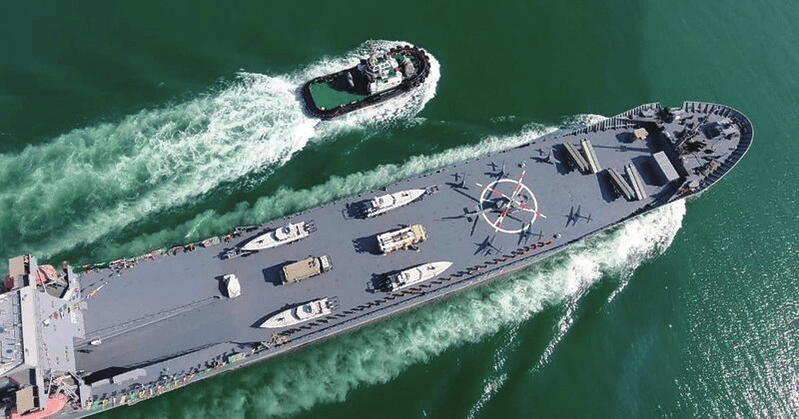Iran announced “domestic aircraft carrier”: can carry drones, helicopters and missiles
[Global Times Comprehensive Report] At a time when relations between Iran and the United States continue to be tense, the Iranian Revolutionary Guards Corps announced the latest “domestic aircraft carrier” that can carry drones, helicopters and various missiles.
The US “Navy Times” stated on the 21st that news about this large battleship was disclosed by the offcricial media of the Iranian Revolutionary Guards, “Sep News”, clearly showing its affiliation. The ship has a total length of 492 feet (about 150 meters), which is much smaller than the US “Nimitz” class aircraft carrier (1092 feet).
From the appearance, it is more similar to a large freighter. It does not have a through deck for the take-off and landing of fighters, but has a flight deck for helicopters to take off, and there are multiple drone ejection devices nearby. In addition, the ship has a very powerful weapon.
The bow is additionally welded with dual-tube 23mm anti-ship missiles, and 4 “Nur” double-mounted anti-ship missile launchers and “Holdad-3” surface-to-surface are arranged in the rear. Air missile.
The report emphasized that the ship’s amidships parked four armed speedboats frequently used by the Iranian Revolutionary Guards. There is also a wide slide in the stern through which the speedboat can quickly enter the water, indicating that the ship may try to integrate the UAV’s intelligence collection capabilities.
Strike capability with anti-ship missiles and armed speedboats. However, all of these weapons and equipment are independently integrated with the ship’s hull, and there is no integration of command and fire control equipment. Obviously, the technology is still quite rough.
But this did not affect the evaluation of the Iranian Revolutionary Guard Naval Commander and Commodore Ali Reza Tansri. He hinted that this large-tonnage warship would help his troops to cross the Gulf and enter the Arabian Sea and even the Indian Ocean for combat readiness patrols. Usually that is the territory of the Iranian navy.
The two naval forces worked in the Iranian Ahmadinejad government. “The Revolutionary Guard is responsible for patrols in the Gulf waters, while the Iranian Navy patrols the Gulf of Oman and other waters.”
However, Tansri emphasized: “It is our right to maintain a presence and perform duties in the Indian Ocean.” The Naval Times believes that the Iranian Revolutionary Guard intends to demonstrate against the U.S. Navy’s Fifth Fleet in Bahrain, which is intensified in and out of the Gulf. Aircraft carriers, destroyers and drones approached Iran, and the two sides have a strong sense of hostility.
Mehrzad Brujdi, a professor at Syracuse University in the United States, said that the signal sent by the new Revolutionary Guard is serious. In recent years, the Revolutionary Guard’s strength has expanded dramatically.
As a quasi-independent organization within the Iranian armed forces, its The field has expanded to include roles such as navy, air force, paramilitary forces, special forces, and cyber warfare. “The seemingly low-end’aircraft carrier-class warship’ can act as a’sea fortress’, providing logistical supplies and command for the Revolutionary Guard speedboats and reconnaissance ships.
Control and other guarantees to improve maritime self-sustainability, as long as it maintains’armed coexistence’ with the U.S. Navy, it will have a deterrent effect.”
From June to July 2018, Iran dispatched the destroyer “Jamaran” to “provide humanitarian assistance to the Yemeni people”, continuously traversing the Saudi and UAE naval blockades, and entering the Hudeida port occupied by the Houthi armed forces. “In my opinion, such a task is very likely to be handed over to the Revolutionary Guards Navy in the future, which has more resources and capabilities.”



